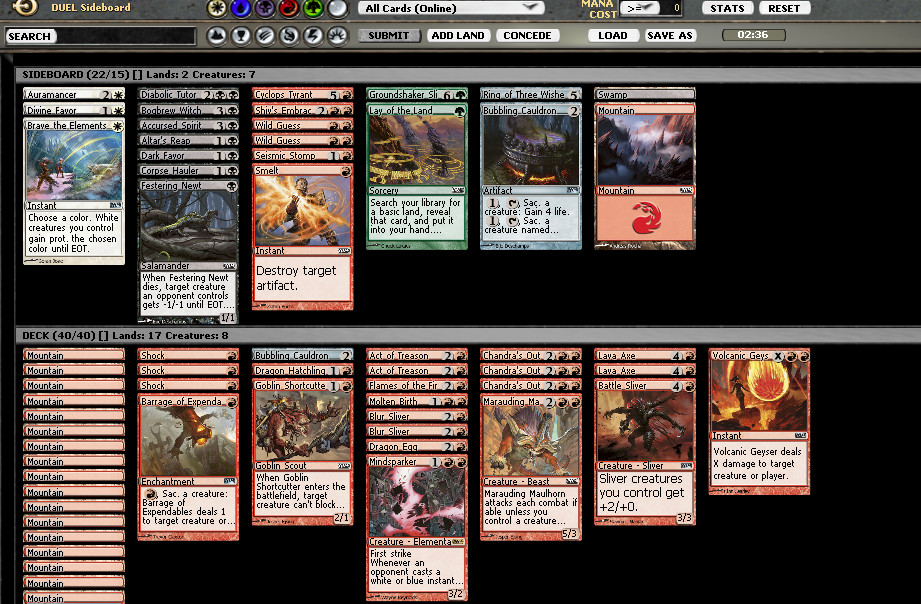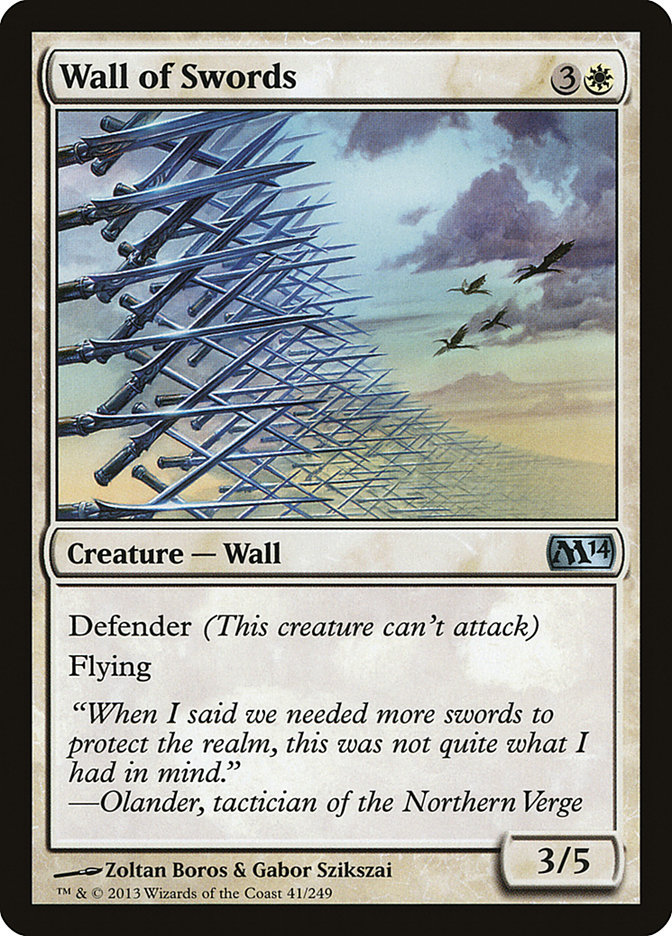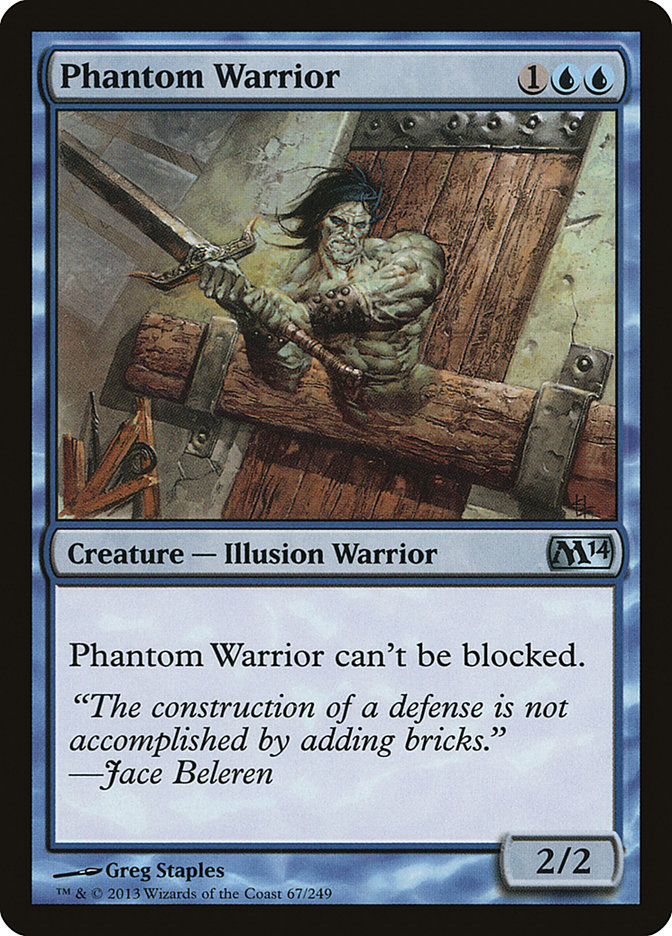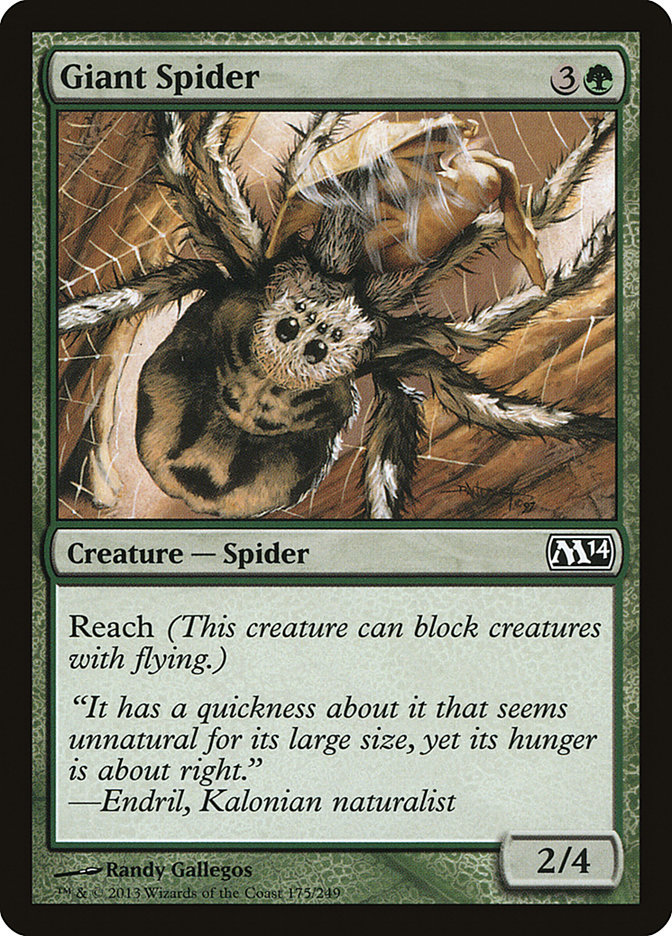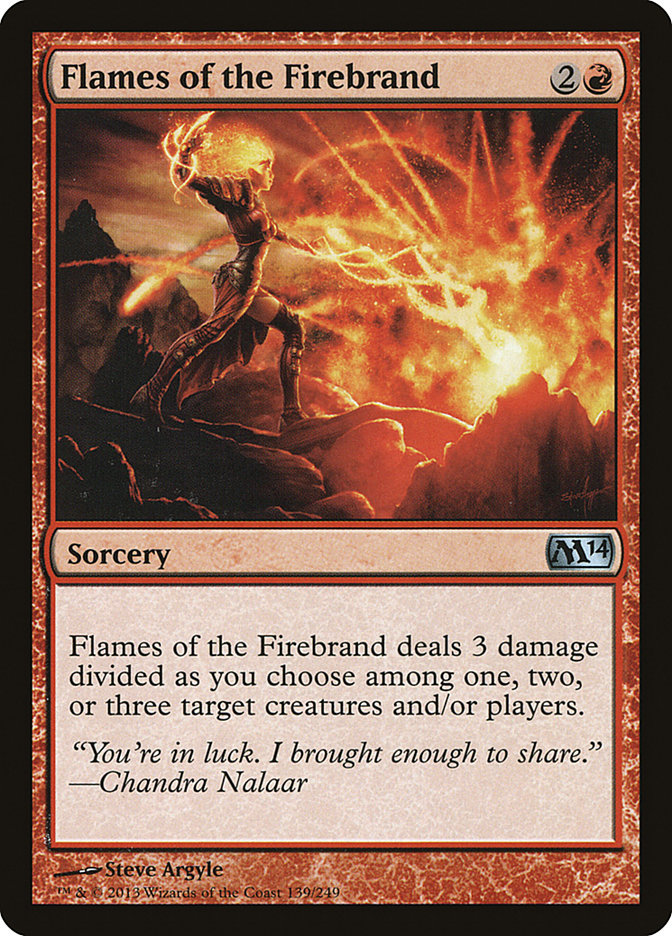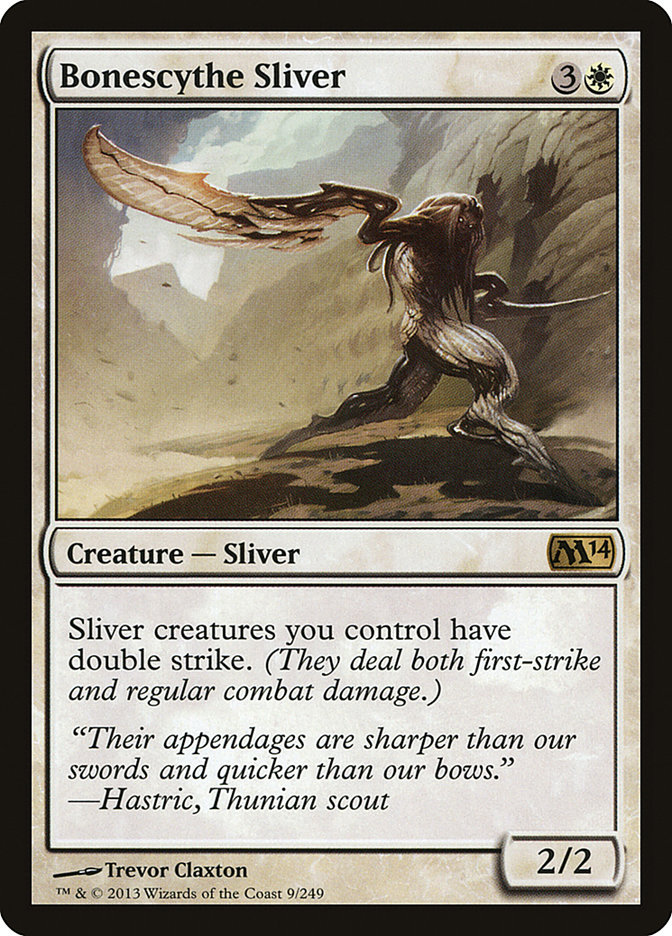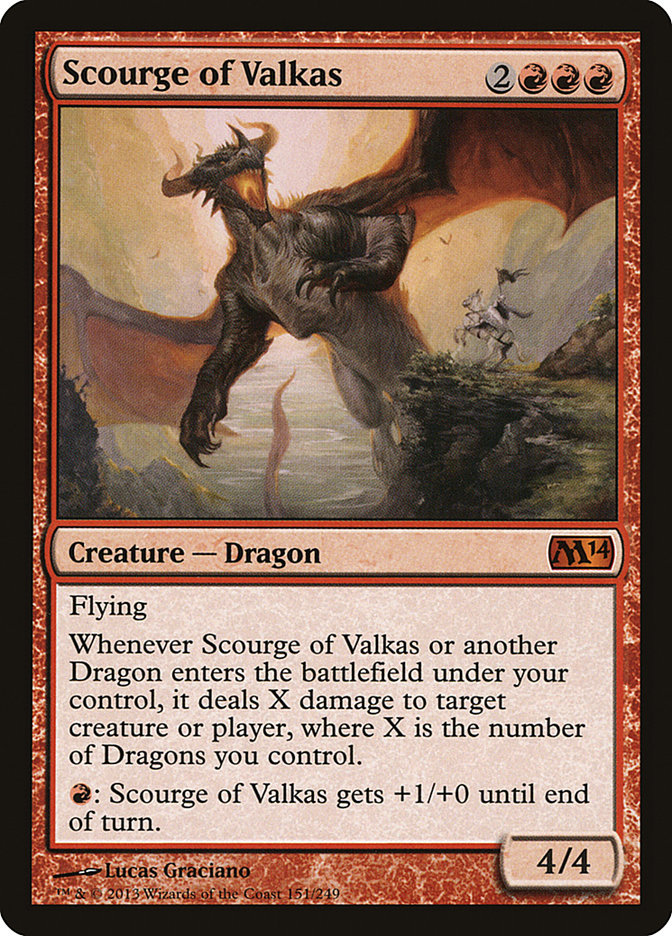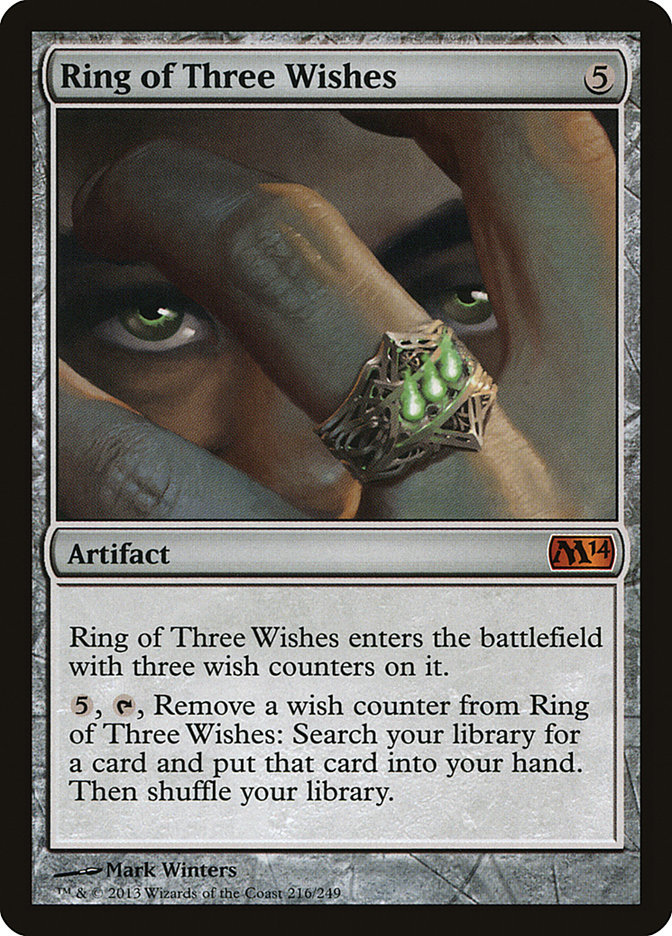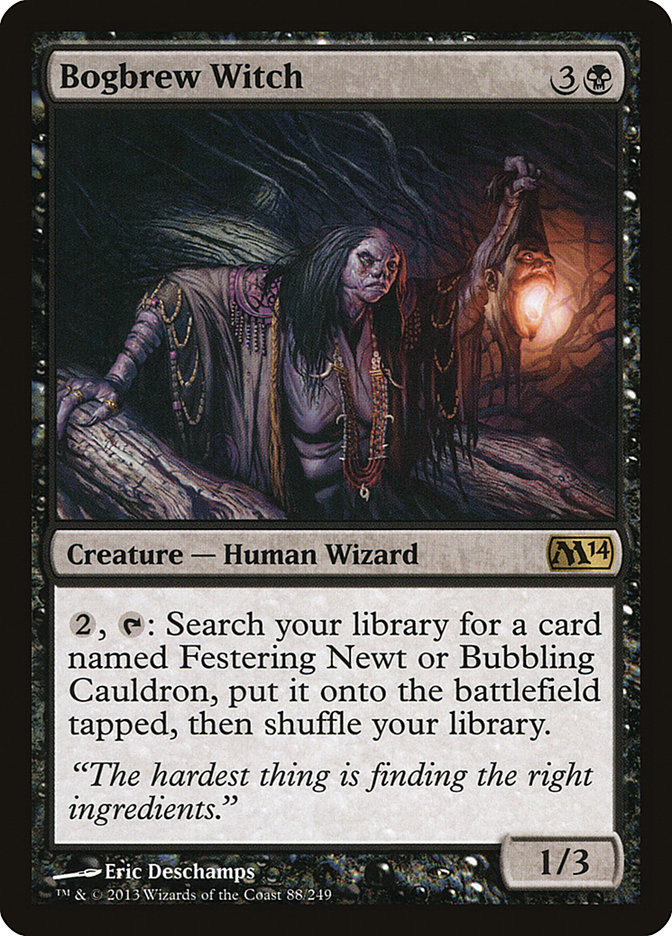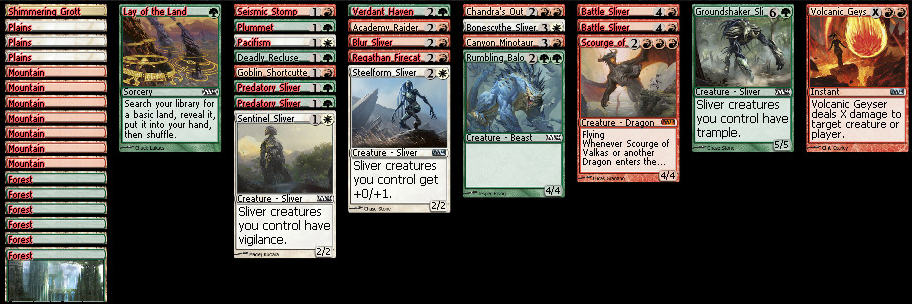The current competitive format is M14 Sealed and Draft, and while I originally hated the format due to its seemingly simplistic nature—it seemed like only fliers mattered and that every game took 1,000 turns—I have come around to quite like the format for numerous reasons, including the fact that every game can grind to a screeching halt where only fliers matter. A format where you can and should be first-picking Opportunity doesn’t come along very often
Draft
While there is a "best color," a "worst color," and perhaps even a "best deck" (even if it is just more or less mono-the best color), you can draft almost anything you want in this format and remain competitive. But that almost really does mean almost, though, as white in this format is a new kind of bad. There are about seven white commons you could conceivably want in a normal Draft deck, and that’s including Angelic Wall, Auramancer, and Hive Stirrings—all of which are very specialized (you don’t want them in every deck.)
But the freedom to go deep in this format is very real, and Elixir of Immortality is certainly a large contributor to that. I’ve seen Chris Manning’s double Angelic Wall, quadruple Divination, double Archaeomancer, Congregate, Elixir, Colossal Whale deck quite literally never lose until there was nothing left to do but win. At the same time, Sam Black has been touting drafting mono-blue in this format since the second week it’s been online. While I don’t want to spend a ton of time today talking about drafting because that’s been covered ad nauseam by everyone with a microphone, I do think there are a few things worth talking about before we dive into Sealed.
Theoretically, because everyone knows blue is the best color, it’s assumed everyone wants to draft it. I decided I’d like to practice specifically not drafting it, which led to some interesting results. Anyone who watches my stream knows I have a penchant for drafting monocolored decks even when I perhaps should not do so, but now I sort of had a reason to do it if I could. That being said, there is a pretty big payoff in this format for a few colors, and I’ve even succeeded with a couple of mono-red decks for which the payoff was simply getting the lion’s share of Chandra’s Outrages and Shocks in the middle of pack 2 and late in pack 3.
As you can see here, I clearly got a little lucky with the cards that were opened, but once I started cutting red heavily in pack 1, I created a seat for myself in the draft where I could reap the rewards of no nearby players drafting my colors. I think I settled on being mono-red in this draft around pick 5 of pack 1 with a marginal Red card and then never looked back. For what it’s worth, I do think mono-red is a real thing, and I’ve 3-0ed at least twice with great-looking decks featuring all kinds of pumpable Dragon creatures and all kinds of bad and good spells.
The other rewards are more obvious—they hit you right upside the head. Howl of the Night Pack, Corrupt, and Staff of the Mind Magus are your rewards should you choose to accept your mission (or whatever). You want to start your mono-green decks off with Howl if possible, although don’t pick it over Kalonian Tusker—it isn’t better. Even better would be if one wheeled to you or if you got passed one late when you were already heavy green in your first pack.
Similarly, Staff of the Mind Magus is a card that is excellent in mono-blue (whereas the other Staffs are not necessarily good because the other colors have a lot of trouble generating card advantage). You want to wheel your Staffs, though, unless you’re taking them seventh pick or so. Anyone in the know might hate draft one if they get a shot, but more often than not you can get one late and should take it. The combination of Divination and Archaeomancer makes your Staffs all the better, and the incremental life gain can be overwhelming because there’s not a real great aggressive strategy in the format, which is sort of why any and all of this is possible.
That is the crux of the format. Opportunity is the best non-rare (or mythic rare) because you almost never die so fast that you can’t cast it; if you can draw enough answers off your Opportunity to not die the turn you untap after casting it, you’re probably going to win since you just drew four cards. As Jon Finkel likes to say, "Any format where you can and should first-pick Opportunity is a good one." It doesn’t hurt that mana fixing isn’t abundant, making it so everyone isn’t playing every good card they open. The only mana fixing is Shimmering Grotto, Darksteel Ingot, Verdant Haven, and Lay of the Land, which means that if you don’t have a Trading Post you probably won’t be the happiest camper playing the Ingot. No one is happy to play the Grotto, and the other two are Green—Green, of course, is the color that should have mana fixing, so I don’t have any problem with that.
The last of the monocolored cards is Corrupt, and it’s a doozy. More often than not it’s a removal spell that lets you attack with impunity for a few turns, thus winning the race. Sometimes you can just go right to the face with it a-la-Fireball, but like Howl and Staff it isn’t especially strong in a non-monocolored deck. It’s okay to Corrupt for three, but it isn’t exciting, so it gets passed a lot. You can get Corrupt pretty late sometimes, and that’s a pretty good reason to be in a heavy- or mono-black deck since the rest of the pieces are there and you want them anyway.
I want to mention a few specific cards now because I don’t feel like they are being evaluated properly.
An excellent white card that at times is better than Serra Angel. While it cannot attack for four like Serra Angel can, the fact that it does not die to Chandra’s Outrage means that it is an amazing card for any of your more defensive white decks. I would go as far as to say this is potentially a reason to go white. These go pretty late right now, so don’t be afraid to pick them up!
This is about as bad as Wall of Swords is good. Other than U/G—which some people don’t even think of as an archetype—there really isn’t a place for a strictly aggressive blue creature. You could end up with enough Charging Griffins and Serra Angels to have an aggressive U/W deck, but it won’t come together very often. Frankly, I am surprised that I don’t see Phantom Warriors later in drafts.
Ordinarily, Giant Spider and its ilk are very desirable creatures, but in this format, most of the fliers have the ability to simply break through a Giant Spider or at least trade with one. You’re only going to be holding off their Seacoast Drakes and their Griffin Sentinels for the most part, so please don’t get too excited about Giant Spider. I still think you need to maindeck it in Sealed because everyone is going to play as many fliers as they can, but you shouldn’t be drafting this card too highly or looking to it as a reason to play green.
This is a tough one for me to write, as card advantage has been ingrained in me since my formative years, but indeed in this format, you won’t get an insane two-for-one very often. The creatures are of odd sizes, and often you’ll have to trade off one of your worse guys to kill their random 2/3 and then get to pick off whatever leftovers they have. The best utility creature that comes to my mind is Young Pyromancer; you can get some value there, but for the most part you’re going to want to take the common removal over this almost without exception. Chandra’s Outrage is actually the best of the red removal for those wondering.
Because I’d like to dive into Sealed, I will leave you to read other articles on the topic to see "pick orders" (pick orders are dynamic, so this is a bit silly). I will say there are a few good archetypes to draft (B/R Sacrifice, G/R Aggro, U/G Tempo, Slivers) and that the format is more fun than we gave it credit for originally.
Sealed
There are a few basics to this Sealed format that you can extrapolate from your knowledge of Draft. Opportunity is still king; everyone gets six packs, so they might get an Opportunity and they’re going to need a good reason to not play it. There are no good two-drops, and while Child of Night is on the verge of being unplayable in Draft (it’s worth about half a card), in Sealed you can at least block Accursed Spirit with it, which people will often see as a "3/2 evasion," an attractive package at four mana. I also think that when you’re playing blue with a few Divinations in Sealed there is some hidden value in having a two-drop that you can play to enable you to cast your Divination [on the draw] without discarding because you’ll often want to do that to hit your land drop but might waver due to having to discard from hand size.
So the format is slow, and powerful effects are useful to overcome other late-game effects. It’s hard to build an aggro deck, so people might be underprepared for aggro decks. Generally, I think it’s an eighteen-land format (or seventeen + two mana sources like Gemhide Sliver or Elvish Mystic or Lay of the Land) and more often than not you’re going to want to be on the draw to get the extra card.
I knew all of this going into Grand Prix Oakland, but when push came to shove, I was handed a pool that looked like this:
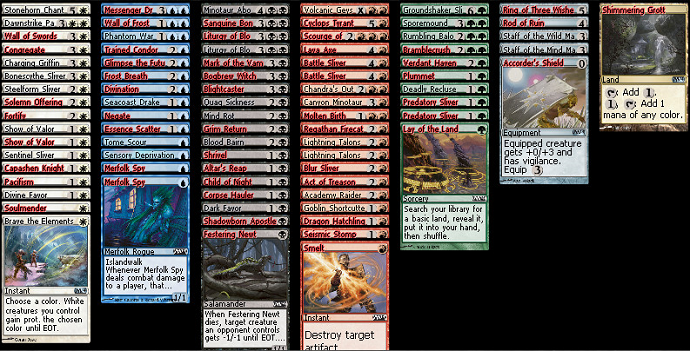
After giving your pool a looking over (to verify the cards), you will of course have seen your rares and gotten a general sense of how good or bad your cards are and where your strongest cards are. For me, that was fairly simple to identify:
First, I consider Bogbrew Witch to be very strong in general, but it does need a supporting cast—probably looking for at least two things to search for. We had one, which makes it pretty borderline ("not playable"). Sanguine Bond is another specialized card. In a deck with enough Cauldrons, Corrupts, and Congregates, it could be useful, but again, this wasn’t a late-night bad-idea event—this was a Grand Prix. Nine rounds and we’re looking to go 8-1 or better to put ourselves in a position to Top 8 and qualify for the Pro Tour.
It is important to note that I did actually have this in mind when I submitted the Sliver deck—"high risk, high reward"—against what I perceived to be a completely average B/R deck. I felt the B/R deck would be an underdog against most blue decks (which is what we were expecting), whereas a fast start with an aggro green creature deck could catch them off guard before they had time to stabilize. I wanted the higher variance since I thought my card pool was on the weaker side, and since I didn’t want to just grind out a 7-2, I was okay with playing the Sliver deck instead of the more consistent black deck.
For rares, that leaves the double strike Sliver, the Scourge, and the Ring. All three of them are good, but the Ring isn’t particularly good in every deck. For example, in the deck I ended up registering, I felt even if I was given free rein to Ring three times I might not be able to win. In addition to that, I ended up playing a pretty aggressive deck, which meant that I wouldn’t want to slow myself down to spend around 20 mana to tutor three times even if I could get my Scourge and my Bonescythe Sliver and my Volcanic Geyser.
So I had to make the typical decisions, balancing power against consistency. I double-checked my pool and saw two Battle Slivers when I saw the Scourge, which meant I’d probably want to be playing red as Battle Sliver is also pretty nice by itself in this format as a 5/3 for five. But once you see the two Battle Slivers and the Blur Sliver as an option, the two Predatory Slivers start looking real good. Then, of course, you talk yourself into playing the Bonescythe Sliver since you have two of the "better" mana-fixing options in this format. I say that half-jokingly, of course. Had we not had the Bonescythe Sliver, I think my better angels may have shouted down my demons, and I would have gone with the averagest-average-average R/B "Ho-Hum.dec." Instead, we ended up here:
Ordinarily, if I’m going to do something, I’d rather go all in. When I draft Slivers in this format, I really don’t like to have non-Slivers in my deck, but in Sealed obviously you’re given what you’re given, so as I was building my deck I envisioned it playing out like an aggressive R/G deck (like one that I’ve drafted a bunch of times) with some nutty opening hand potential. Luckily, in practice that’s more or less how it worked.
Some of the finer points of the format make cards like Naturalize, Solemn Offering, and Plummet maindeckable, but since I was merely splashing white, I didn’t want to start the Solemn Offering. Had it been a Naturalize, I would have been way more interested. I was pleased with the maindeck Plummet throughout the day, and while I don’t recommend starting a Seismic Stomp in general, I liked it a lot in this deck because I had a pretty limited amount of removal and a pretty limited "breakthrough" potential. The ground is easily gummed up in this format, and I didn’t want to have no way to win in a world where they could simply block all my stupid Slivers.
The wheels nearly came off in round 6 when my opponent beat me with a Jace, Memory Adept in game 1 and then had enough removal and fliers that I narrowly lost a third game. I did get to sideboard in Bramblecrush and Lava Axe to deal with Jace, but it sadly didn’t matter. Academy Raider began its stint as MVP this round, and I don’t think it ever really stopped overperforming at all during day 1; smoothing the curve and discarding cards I didn’t want (or simply couldn’t cast) was a real delight.
After losing to Jace, I sought out some build advice from none other than Reid Duke. I consider Reid to be pretty good at building Sealed decks, and sometimes it just takes hearing his confidence to find some of my own. He recommended I go with the boring deck, of course, and I guess I knew he would. It was, after all, the safer deck, playing almost no "bad cards" (Seismic Stomp?) and instead having all of the potential removal and even getting to play the Ring as a nice way to get some card advantage in a color combination that usually cannot.

This deck is, of course, without frills; it has bombs but not frills. It plays almost all of the good cards from its two colors and offers a pretty great solution to playing against a deck with removal (that could potentially break up my Sliver harmony, such as the one I faced in round 6). Note that Reid recommended playing seventeen lands with a deck so heavy on removal, and it sort of makes sense—and that, of course, boarding in Rod of Ruin or not playing the Shortcutter after board could be fine.
After board, you know when you can guarantee you’ll be on the play, so you should use that knowledge to your best ability. You can play an extra land if you know your opponent will put you on the play, or you can shave one if it’s a close call and you know you can choose to draw first. Likewise for crummy two-drops.
I just want to point out that Magic Online offers the nice ability to save your decks for quick loading during sideboarding, so by all means you should take advantage of this if you’re going to participate in any of the upcoming Magic Online PTQs. In real life, however, the switch can be daunting. Do you resleeve your second deck? Do you desleeve the overlapping cards from your other deck? What do you do about lands? My answer is as follows—make it as easy on yourself as you possibly can. Extra lands (match the pictures—don’t give anything away!) sleeve if you can, even with a different color of sleeves would be the most preferable. The information your opponent gains about you submitting a different deck for game 2 or game 3 is far outweighed by the fact that you don’t need to worry about getting a game loss somewhere along the line.
Of course, you can also sideboard normally given that you’ll now know what they have to some effect. In round 8, my opponent was U/G, and his deck was full of great instant creatures (two Nephalia Seakites, Briarpack Alpha) and a ton of countermagic to boot. What he didn’t have was removal, so I kept my Sliver package in, and when he opened the door for me to win on basically the last turn of game 3, I got there.
It’s important to note sometimes if you have two decks, it is quite possible that there may come a time when the better deck isn’t necessarily better against your current opponent’s deck.
As for the rest of my Grand Prix? I did go 8-1 on day 1 and drafted a great deck in the first draft (pod 2) featuring two Tuskers, a Primeval Bounty, a ton of creatures, and a Garruk. I quickly dispatched Jon Finkel in the first round but fell to Wrapter in the second and then lost to some Cyclops Tyrants in the final round. I drafted a poor deck in the second draft, but it turned out the packs were on the weaker side. I ended up losing the finals of that draft to finish in 43rd place. I should have drawn, as the guy who beat me finished in 18th so I think we were essentially playing for nothing (compared to drawing), but the Pro Point has mattered for me in the past and I stand by my decision.
I want to wish you all the best of luck in your upcoming Sealed Deck PTQs. There is at least one on Magic Online and probably more after that if you can’t find any local ones to go to.

